Memories of the Vale
By Eleanor Thomson
In the Shadow of the Ben
It was all taken for granted: the song, the worldwide fame, the beauty, for as a child living in Alexandria in the 1950s, Ben Lomond was an everyday sight; it was simply “the Ben”. Only now do I understand what a profound influence this 3,194 ft (974m) Munro had on my childhood perceptions of the world.
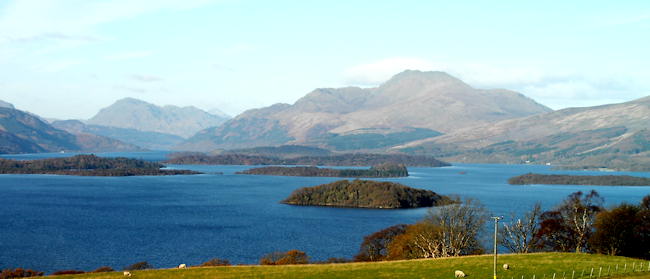
Each season brought its own beautiful colours to the peak of the Ben: the sparkling white of winter snow, the fresh verdant green of spring and the romantic bluish-purple haze of the summer months and the bracken-browns of autumn. The aspects of the Ben acted as our barometer: wreathed in frowning cloud, it told of rain; heavily clothed in snow and sparkling in winter sunlight, it warned of freezing weather; ablaze in glorious sunshine, it radiated the warmth of spring and summer.
All the little rituals of my life as a child in this beautiful part of the West of Scotland countryside were linked to the appearance and mood of this majestic mountain. As the delicate heads of snowdrops appeared in the first warm rays of spring sunshine, so also would the green and lush peak of Ben Lomond begin to emerge from the heavy layers of snow that had clothed it throughout the winter months. When these first rays of sunshine lit the Ben and reflected its crisp inverted image in the still, deep waters of the Loch, spirits dulled by the dark and cold winter months were lifted as though towards its very summit: the Ben, harbinger of all seasons had signalled that better days were ahead.
The prospect of buying fresh eggs from a farm ‘up the loan’ a few miles from the Ben usually marked our first spring outing. The fresh and simple enthusiasm of early childhood observation made nature a novelty as we walked towards the farm. Everything was exciting and significant: the fuzzy buds on the pussy willows, daffodils bobbing in the fresh wind, the bright yellow flowers and hairy leaves of the roadside primroses and the first curling buds unravelling on the trees; all were absorbing sights.
Continuing our steep climb towards the farm, we could hear the sharp plaintive cries of the peeweep (lapwing), the bleating of distant sheep and, nearby, the loud slavering wet munching of cows relishing their cud, their massive rough heads and incurious brown eyes staring at us above the hawthorn hedges bordering the fields. When these sounds were eventually overtaken by the long contented clucking of hens, we knew that we were near the farmhouse. Soon, we could see the hens pecking at what seemed like nothing in the dusty ground. They would scatter with a flurry of their rusty brown feathers and yellow feet as we approached the farmhouse door then reassemble a few yards away to continue with their gossipy croaks and cackles, moving slowly with their stiff-legged, hesitant plod, their bright, reptilian eyes focused on the ground.
The eggs we bought were invariably smeared with hen’s droppings and with pieces of golden straw from their nests still clinging to the brown shells.
Walking back down the hill from the farm, we could see the comforting summit of Ben Lomond, its diminishing cap of snow winking in the sunlight, white against a blue sky.
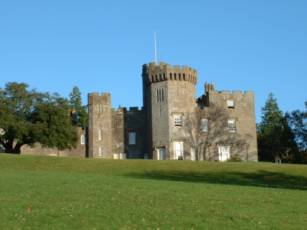 Other wonderful days were spent walking through Balloch Park to the sandy shores of Loch Lomond, spotting the red squirrels that once thrived in the park amongst the pines and rhododendrons, visiting Balloch Castle on the West Bank of the Loch and frightening each other with tales of the white wraiths or ghostly green ladies we had seen there.
Other wonderful days were spent walking through Balloch Park to the sandy shores of Loch Lomond, spotting the red squirrels that once thrived in the park amongst the pines and rhododendrons, visiting Balloch Castle on the West Bank of the Loch and frightening each other with tales of the white wraiths or ghostly green ladies we had seen there.
Memories of the summer, autumn and winter months are as an older child, set on a life of adventure. The summer months were marked by impromptu cycling trips to Loch Lomondside.
One of us would decide, others would agree, sandwiches would be wrapped, pocket money would be pooled and Cocozza’s, the local Italian ice cream shop, would be swamped by half a dozen excited ten year olds looking for lemonade and sweets for the trip.
Duck Bay or the pretty village of Luss was our usual destination on these glorious days during the school summer holidays. When we arrived, breathless and exhilarated by our bike rides, we were happy to throw ourselves on the grass and rest, gazing at the Ben on the far shores of Loch Lomond. We ate our picnics listening to the peaceful chug of a motorboat heading for a suitable fishing spot or the distant thrum of the massive engines and swish of the giant paddles of the old steamboat, The Maid of the Loch.
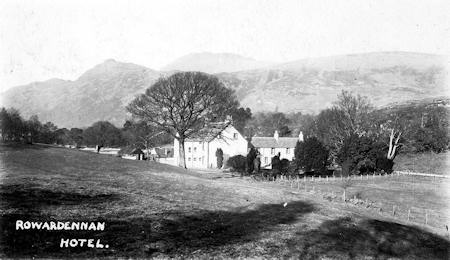 Sometimes, during the summer holidays, some of the better-off children in our street who had parents with a car would organise in advance the military-like manoeuvres needed to climb to the tantalising bluish-purple-hazed summit of the Ben. Promises were made that the first sunny weekend would bring an early rise, egg and tomato sandwiches and several sweaty hours climbing to the peak.
Sometimes, during the summer holidays, some of the better-off children in our street who had parents with a car would organise in advance the military-like manoeuvres needed to climb to the tantalising bluish-purple-hazed summit of the Ben. Promises were made that the first sunny weekend would bring an early rise, egg and tomato sandwiches and several sweaty hours climbing to the peak.
When we arrived at the stony summit every nettle sting, every scraped knee and twisted ankle were forgotten. The exhilarating view from the Ben on a good day stretches for miles in every direction: with the dark waters of Loch Lomond below and the Highlands in the distance, it felt like we were seeing the whole of Scotland.
The climb down for the more adventurous amongst us was a mad dangerous scramble. The mothers who had decided not to climb, preferring to relax for a peaceful few hours by the waterside would have a fire lit on the pebbly shores at Rowardennan with pots of tea brewing for our return.
A peak turned bracken brown marked the onset of autumn and time for more childhood rituals. Tumshies (turnips) had to be found from which we would carve Halloween lanterns; old clothes had to be found for guising; flammable materials had to be squirrelled away for the bonfire on the 5th of November; pocket money had to be earned for the fireworks that would mark the occasion of Guy Fawkes’ attempt on the Houses of Parliament: and raids made on horse chestnut trees to play ‘conkers’. The game involved taking the inedible hard nut from the tree – the “conker” – and hanging it from a piece of string whilst an opponent attacked it in the hope of smashing it by striking it with their “conker”.
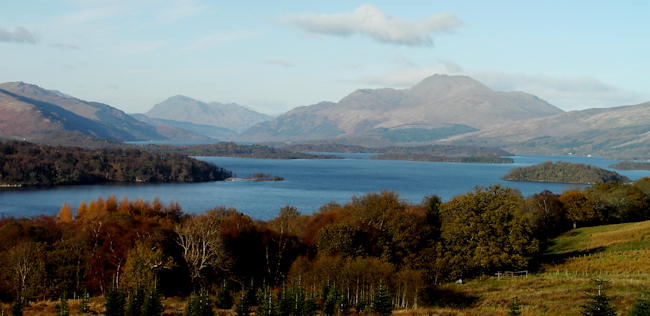
The tree parted with the nuts quite naturally late in the autumn but patience has never been a virtue amongst children: the chestnuts we most coveted hung out of reach amongst the high spreading branches of ‘our’ tree not far from the Loch.
Placing ourselves under the tree, necks cricking painfully as we gazed upwards, we would begin our assault. Up went the damp lumps of wood, the boulders and clods of earth. Each try was an Olympic effort supported by encouraging cries of the others. We were not unaware of the dangers: what went up came down and we were adept at dodging missiles returning to earth.
When the prize was won and we had enough chestnuts to play our games, the real contest began: preparing the conkers for battle. Great delight was taken in prising the large brown nut of the horse chestnut tree from its secret pithy home inside its prickly coat. Each brown nut had to be firm with no cracks. Holes were made in the centre of each nut with a knitting needle. A knotted piece of string was threaded through the hole and the nut hung from the end. Often the chestnut was soaked in vinegar until it was as hard as wood and slightly wizened; a chestnut that was destined to win many battles. Bruised knuckles from badly aimed swings were common and brave faces put on when our hard-earned nuts were broken to fragments in minutes by an opponent with a good aim.
By then, the Ben’s summit would have donned a winter coat, the tell-tale sign of a changing season. Gradually, over the weeks, the peak would disappear under layers of snow and then become distant and moody, covered by freezing clouds. Winter was upon us; time for wrapping up warmly whilst looking forward to the rituals of Christmas and the New Year.
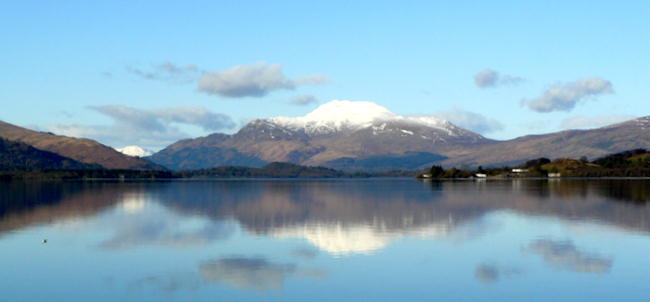
The wonderful variety of nature’s changing colours at the summit of the Ben; an inverted image reflected the glassy surface of Loch Lomond; long walks in the springtime; fresh eggs for breakfast; cycle rides; climbing the steep slopes of the Ben; nursing bruised knuckles; the smell of singed turnip and hot candle grease at Halloween; the sound of crackling wood and fireworks: all have become a vast mosaic of memories, each piece of the mosaic reminding me of a wonderful childhood spent in my own special place in the world in the shadow of the Ben.


